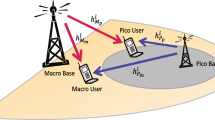Abstract
Group-orthogonal multi-carrier code division multiple access (GO-MC-CDMA) has recently been proposed as a promising technique for the uplink segment of wireless systems. In this paper we propose and analyze a related scheme, group-orthogonal multi-carrier code division multiplexing (GO-MC-CDM), suitable for the downlink segment of the future generation of wireless systems. The proposed system is shown to offer a similar bit error rate (BER) performance as the downlink version of GO-MC-CDMA at a fraction of its computational complexity. An analytical expression for the BER when using maximum likelihood (ML) detection is derived providing valuable insight into the parameters affecting the system performance and providing a basis for its optimization. Simulation results using parameters and (correlated) channel models aiming at the next generation of wireless systems are provided confirming the analytically derived results.
Similar content being viewed by others
References
Bury, A., Egle, J., & Lindner, J. (2003). Diversity comparison of spreading transforms for multicarrier spread spectrum transmission. IEEE Transactions on Communications, 51, 774–781.
Cai, X., Zhou, S., & Giannakis, G. B. (2004). Group-orthogonal multicarrier CDMA. IEEE Transactions on Communications, 52, 90–99.
Craig, J. W. (1991). A new, simple and exact result for calculating the probability of error for two-dimensional signal constellations. In IEEE MILCOM’91 conf. rec., Boston, MA (pp. 25.5.1–25.5.5).
Fazel, K., & Kaiser, S. (2003). Multi-carrier and spread spectrum systems. New York: Wiley.
Femenias, G. (2004). BER performance of linear STBC from orthogonal designs over MIMO correlated Nakagami-m fading channels. IEEE Transactions on Vehicular Technology, 53, 307–317.
Hara, S., & Prasad, R. (1997). Overview of multicarrier CDMA. IEEE Communications Magazine, 35, 126–133.
Hochwald, B. M., & ten Brink, S. (2003). Achieving near-capacity on a multiple-antenna channel. IEEE Transactions on Communications, 51, 389–399.
Kaiser, S. (2002). OFDM code-division multiplexing in fading channels. IEEE Transactions on Communications, 50, 1266–1273.
MATRICE (2003). European union framework program 5. https://www.ist-matrice.org/.
Proakis, J. G. (1996). Digital communications (3rd ed.). Boston: McGraw-Hill.
Riera-Palou, F., Femenias, G., & Ramis, J. (2006). On the design of group-orthogonal MC-CDMA systems. In Proc. IEEE signal processing advances in wireless comms., Cannes, France (pp. 1–5).
Schwartz, M., Bennett, W. R., & Stein, S. (1995). Communications systems and techniques. Wiley-IEEE Press.
Tafazolli, R. (Ed.). (2006). Technologies for the wireless future: Wireless world research forum (WWRF), Vol. 2. Wiley-Interscience.
WINNER (2005). European union framework program 6. https://www.ist-winner.org/.
Yee, N., Linnartz, J.-P., & Fettweis, G. (Eds.) (1993). Multi-carrier CDMA in indoor wireless radio networks. In Proc. IEEE int. symp. on pers., indoor and mob. rad. comm., Yokohama, Japan (pp. 109–113).
Author information
Authors and Affiliations
Corresponding author
Rights and permissions
About this article
Cite this article
Riera-Palou, F., Femenias, G. & Ramis, J. BER analysis of group-orthogonal multicarrier code-division multiplex systems. Telecommun Syst 36, 97–105 (2007). https://doi.org/10.1007/s11235-007-9051-3
Published:
Issue Date:
DOI: https://doi.org/10.1007/s11235-007-9051-3




